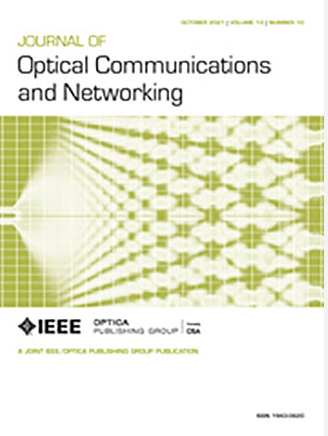Simplified coherent TDM-PON in upstream burst-mode detection with enhanced DC leakage tolerance
IF 4.3
2区 计算机科学
Q1 COMPUTER SCIENCE, HARDWARE & ARCHITECTURE
引用次数: 0
Abstract
This paper investigates the generation and impact of optical DC leakage in upstream burst-mode coherent TDM-PON systems. In upstream burst transmission, the laser remains on to avoid wavelength drift even when the optical network unit (ONU) is inactive, leading to the generation of residual DC leakage caused by a limited modulator extinction ratio and bias drift from the null point. As the number of ONUs increases, the accumulated optical DC leakage becomes large. In a more extreme case, where the optical signal comes from a distant ONU and all the other inactive ONUs are located close to the optical line terminal, the accumulated DC power can even exceed the signal power, resulting in SNR degradation and increased quantization noise. To address these challenges, we propose a flipped-frequency heterodyne detection scheme combined with SCM signaling. This approach upconverts the DC tones from low-frequency regions to high-frequency regions, allowing DC leakage to be effectively filtered out by the bandwidth-limited receiver before analog-to-digital conversion. As a proof of concept, we analyze the impact of DC leakage in both the time and frequency domains, compare the DC tolerance of PAM and SCM under different detection schemes, and support our findings with both simulation and experimental results. Finally, a 200G upstream simplified coherent TDM-PON system is experimentally demonstrated, showing up to 18 dB improvement in DC leakage tolerance compared to a baseband PAM4 signal at the 29 dB N1 class loss budget.增强直流漏容的上游突发模式检测中简化相干TDM-PON
本文研究了上游突发模相干TDM-PON系统中光直流泄漏的产生及其影响。在上游突发传输中,即使光网络单元(ONU)不工作,激光也保持开启状态以避免波长漂移,从而导致由于调制器消光比有限和零点偏压漂移而产生的残余直流泄漏。随着onu数量的增加,累积的光直流漏变大。在更极端的情况下,当光信号来自较远的ONU,而其他所有非活动ONU都位于光线路终端附近时,累积的直流功率甚至可能超过信号功率,导致信噪比下降,量化噪声增加。为了解决这些挑战,我们提出了一种结合单片机信号的倒频外差检测方案。这种方法将直流音调从低频区域上转换到高频区域,允许带宽有限的接收器在模数转换之前有效地滤除直流泄漏。作为概念验证,我们分析了直流泄漏在时域和频域的影响,比较了PAM和SCM在不同检测方案下的直流容差,并通过仿真和实验结果支持了我们的发现。最后,实验证明了一个200G上游简化相干TDM-PON系统,在29 dB N1类损失预算下,与基带PAM4信号相比,直流泄漏容限提高了18 dB。
本文章由计算机程序翻译,如有差异,请以英文原文为准。
求助全文
约1分钟内获得全文
求助全文
来源期刊
CiteScore
9.40
自引率
16.00%
发文量
104
审稿时长
4 months
期刊介绍:
The scope of the Journal includes advances in the state-of-the-art of optical networking science, technology, and engineering. Both theoretical contributions (including new techniques, concepts, analyses, and economic studies) and practical contributions (including optical networking experiments, prototypes, and new applications) are encouraged. Subareas of interest include the architecture and design of optical networks, optical network survivability and security, software-defined optical networking, elastic optical networks, data and control plane advances, network management related innovation, and optical access networks. Enabling technologies and their applications are suitable topics only if the results are shown to directly impact optical networking beyond simple point-to-point networks.

 求助内容:
求助内容: 应助结果提醒方式:
应助结果提醒方式:


